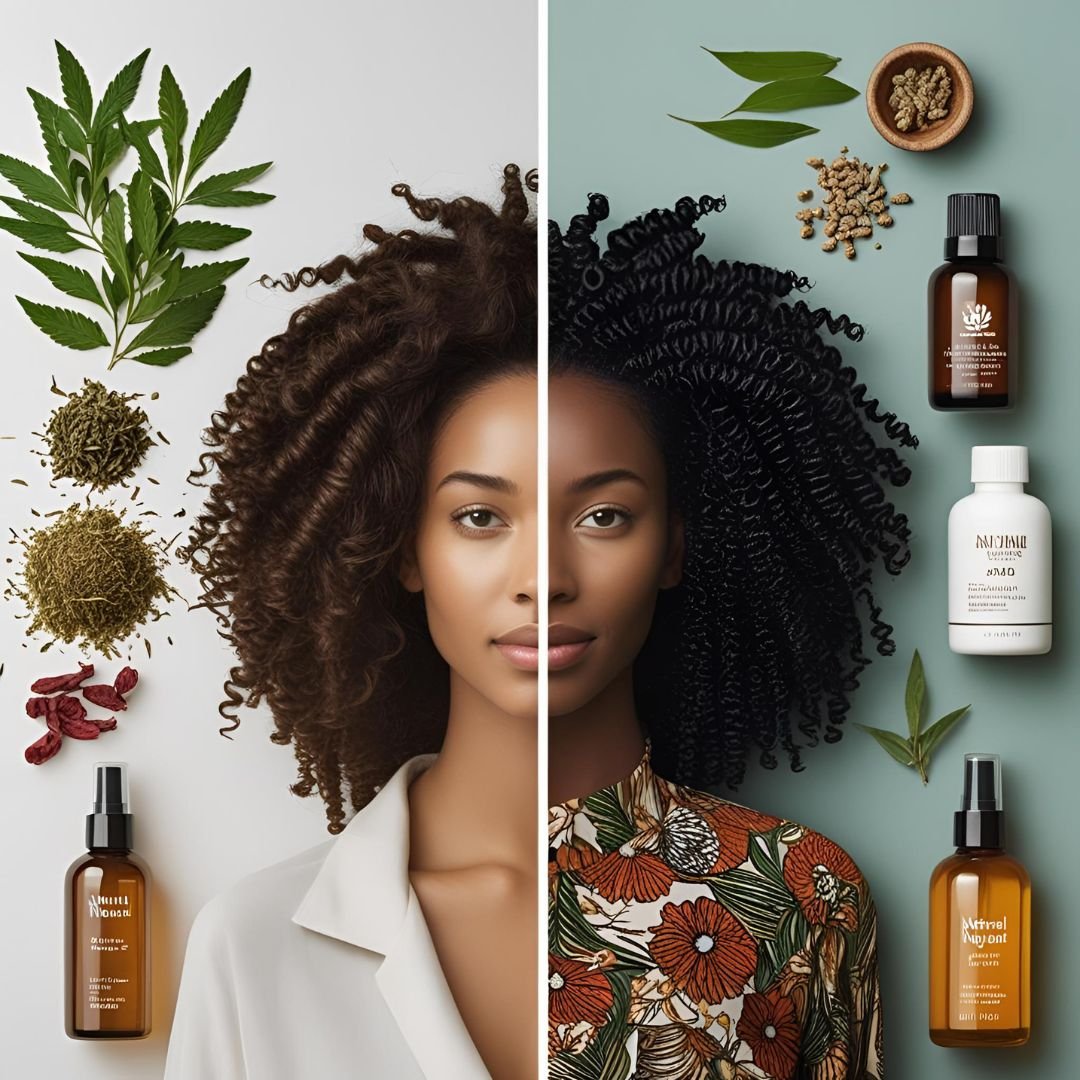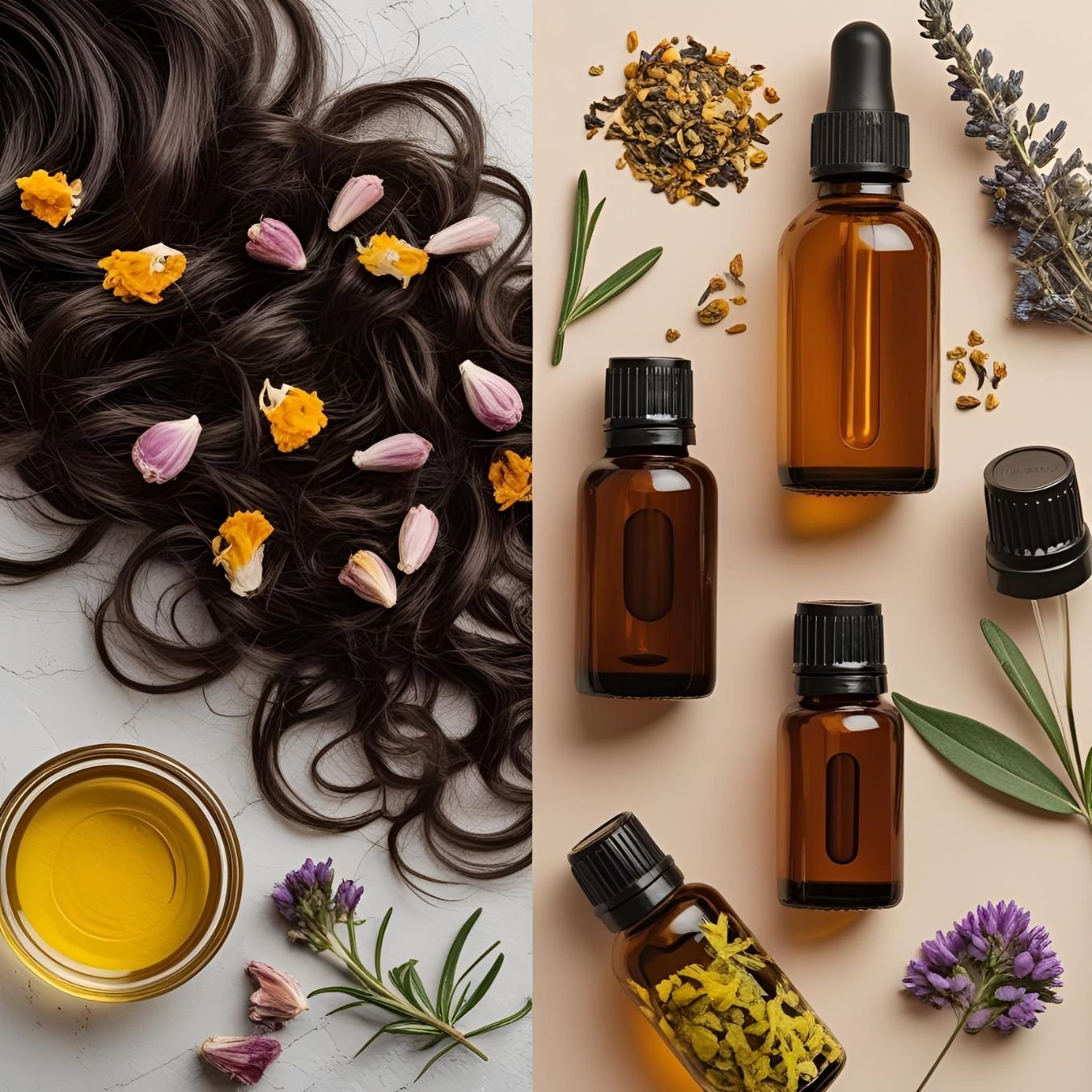The beauty industry is experiencing a seismic shift. Consumers are increasingly questioning what goes into their hair care products, driven by growing awareness of the potential long-term effects of synthetic chemicals. But making the switch from conventional to herbal hair care isn't just about swapping products—it's about understanding the science, managing expectations, and navigating the transition period effectively. This comprehensive guide will help you make informed decisions about your hair care journey, backed by scientific evidence and practical advice.
Understanding the Fundamental Differences
Before diving into the transition process, it's crucial to understand how herbal and chemical-based products differ at a molecular level:
Chemical-Based Products: The Quick Fix
Conventional hair products often work through:
- Synthetic coating agents: Silicones that temporarily smooth hair cuticles
- Strong surfactants: Sulfates that create lather but strip natural oils
- Preservative systems: Parabens and formaldehyde-releasers for extended shelf life
- Instant results: Immediate visual improvements that may mask underlying damage
Herbal Products: The Long Game
Natural hair care works differently:
- Plant-based actives: Compounds that nourish and repair over time
- Gentle cleansers: Saponins and mild surfactants that preserve natural oils
- Natural preservatives: Essential oils and vitamin E for shorter but safer shelf life
- Cumulative benefits: Gradual improvements in hair health from within
"The difference between chemical and herbal hair care is like the difference between makeup and skincare—one covers, the other heals."
The Science: What Research Tells Us
Recent studies have shed light on the long-term effects of both approaches:
- A 2023 study in the Journal of Cosmetic Dermatology found that sulfate-free, plant-based shampoos maintained scalp microbiome diversity better than conventional products
- Research from 2022 showed that regular use of silicone-based products can lead to "build-up syndrome," reducing hair's ability to absorb moisture
- A longitudinal study found that users who switched to herbal hair care showed 40% improvement in hair strength after 6 months
- Clinical trials demonstrate that certain plant extracts (like saw palmetto and green tea) can be as effective as synthetic ingredients for specific conditions
Ingredient Comparison: Decoding Your Labels
| Function | Chemical Ingredient | Herbal Alternative | Key Differences |
|---|---|---|---|
| Cleansing | Sodium Lauryl Sulfate (SLS) | Soapnut, Shikakai, Coco-glucoside | Gentler, maintains natural oils |
| Conditioning | Dimethicone, Cyclopentasiloxane | Argan oil, Shea butter, Aloe vera | Nourishes vs. coats |
| Preserving | Parabens, Phenoxyethanol | Vitamin E, Rosemary extract, Citric acid | Shorter shelf life but safer |
| Fragrance | Synthetic fragrance (parfum) | Essential oils, Plant extracts | Therapeutic benefits vs. just scent |
| Thickening | Carbomer, PEG compounds | Xanthan gum, Guar gum | Biodegradable, non-toxic |
| Color | FD&C dyes, Synthetic colorants | Beta-carotene, Chlorophyll, Mica | May vary batch to batch |
The Hidden Costs of Chemical Hair Care
Sulfates: The Harsh Cleansers
Found in: 90% of conventional shampoos
Effects:
- Strips natural oils
- Can cause scalp irritation
- May fade color treatments
- Disrupts scalp pH balance
Silicones: The False Smoothers
Found in: Most conditioners and serums
Effects:
- Creates build-up over time
- Prevents moisture absorption
- Can weigh hair down
- Requires harsh cleansers to remove
Parabens: The Controversial Preservatives
Found in: 70% of hair products
Concerns:
- Potential endocrine disruption
- Accumulation in body tissues
- Environmental persistence
- Allergic reactions in sensitive individuals
Formaldehyde Releasers: The Hidden Danger
Found in: Many straightening treatments
Risks:
- Classified as carcinogenic
- Respiratory irritation
- Scalp sensitization
- Hair protein damage
The Power of Herbal Alternatives
Plant Proteins: Natural Strengtheners
Examples: Wheat, soy, quinoa proteins
Benefits:
- Repairs damaged cuticles
- Improves elasticity
- Adds volume without weight
- Biodegradable and sustainable
Botanical Oils: Deep Nourishers
Examples: Argan, jojoba, coconut
Benefits:
- Penetrates hair shaft
- Provides essential fatty acids
- Natural UV protection
- Antimicrobial properties
The Transition Period: What to Expect
Switching to herbal hair care isn't instantaneous. Your hair and scalp need time to adjust. Here's a realistic timeline:
Weeks 1-2: The Detox Phase
What happens: Your scalp begins adjusting to gentler cleansers
Common experiences:
- Hair may feel heavier or greasier
- Possible increase in oil production
- Hair might feel "different" or less soft
Tips: Use clarifying treatments, be patient, avoid over-washing
Weeks 3-4: The Adjustment Phase
What happens: Natural oil production starts to regulate
Common experiences:
- Scalp feels healthier
- Hair texture begins changing
- Less dependency on styling products
Tips: Experiment with application amounts, try different herbal combinations
Weeks 5-8: The Improvement Phase
What happens: Hair begins showing signs of improved health
Common experiences:
- Increased shine and softness
- Better manageability
- Reduced hair fall
Tips: Establish a consistent routine, document changes
Weeks 9-12: The Transformation Phase
What happens: Full benefits become apparent
Common experiences:
- Stronger, healthier hair
- Balanced scalp
- Natural volume and texture
Tips: Fine-tune your routine, celebrate the journey
Common Myths Debunked
MYTH: Natural products don't clean as well
FACT: Plant-based surfactants clean effectively without stripping natural oils. The lack of excessive foam doesn't mean less cleaning power.
MYTH: Herbal products are always hypoallergenic
FACT: Natural doesn't automatically mean allergy-free. Some people are sensitive to plant proteins or essential oils.
MYTH: Chemical products work faster, so they're better
FACT: Quick fixes often mask problems rather than solving them. Herbal products work by improving hair health from within.
MYTH: Natural hair care is more expensive
FACT: While initial costs may be higher, you often need less product and see long-term savings from healthier hair.
Making the Switch: A Practical Guide
Pre-Transition Checklist
- Clarify hair with a final sulfate wash or apple cider vinegar rinse
- Document your hair's current condition with photos
- Research and purchase transitional products
- Set realistic expectations (3-month commitment minimum)
- Identify your hair type and specific concerns
- Join support communities or forums for encouragement
Step-by-Step Transition Strategy
- Week 1: Replace your shampoo with a sulfate-free herbal option
- Week 2: Introduce a natural conditioner or hair mask
- Week 3: Add pre-wash oil treatments
- Week 4: Replace styling products with natural alternatives
- Week 5: Incorporate herbal rinses (ACV, green tea, herbs)
- Week 6: Adjust washing frequency based on scalp response
- Week 7-8: Fine-tune product amounts and combinations
- Week 9-12: Establish your personalized routine
Troubleshooting Common Transition Issues
Problem: Excessive Oiliness
Why it happens: Scalp overproducing oil after years of harsh stripping
Solution:
- Use dry shampoo made from arrowroot or cornstarch between washes
- Apply clay masks weekly to absorb excess oil
- Gradually extend time between washes
- Focus shampoo on scalp, not lengths
Problem: Dry, Tangled Hair
Why it happens: Hair adjusting to lack of silicone coating
Solution:
- Deep condition weekly with natural masks
- Use leave-in treatments with aloe or glycerin
- Apply oils to damp hair for better absorption
- Protect hair while sleeping with silk/satin
Problem: Lack of Volume
Why it happens: Build-up removal revealing hair's true texture
Solution:
- Use volumizing herbs like amla or reetha
- Rinse with diluted apple cider vinegar
- Apply products to ends only, avoiding roots
- Try root-lifting massage techniques
Building Your Natural Hair Care Arsenal
Essential Starter Kit
- Gentle cleanser: Sulfate-free shampoo or cleansing herbs
- Moisturizer: Natural conditioner or hair mask
- Treatment oil: Coconut, argan, or jojoba oil
- Clarifier: Apple cider vinegar or bentonite clay
- Protein treatment: Egg mask or hydrolyzed plant proteins
- Herbal rinse: Green tea, rosemary, or nettle infusion
The Environmental Impact
Choosing herbal over chemical isn't just personal—it's planetary:
- Water pollution: Synthetic chemicals persist in waterways, affecting aquatic life
- Biodegradability: Plant-based ingredients break down naturally
- Packaging: Many natural brands use eco-friendly packaging
- Carbon footprint: Plant cultivation generally has lower emissions than chemical synthesis
- Microplastic reduction: No synthetic polymers that become microplastics
Special Considerations
For Color-Treated Hair
- Natural products can affect color differently than chemicals
- Some herbs (like chamomile or henna) may alter tone
- Sulfate-free formulas help preserve color longer
- Consider natural color alternatives like henna or indigo
For Chemically Processed Hair
- Transition may take longer (4-6 months)
- Focus on protein treatments initially
- May need to trim damaged ends progressively
- Be extra gentle during transition
For Sensitive Scalps
- Patch test all new products
- Start with fragrance-free options
- Introduce one product at a time
- Keep a reaction diary
Ready to Make the Switch?
Start your journey to healthier, chemical-free hair with our carefully formulated herbal hair care collection.
Explore Natural Hair CareThe Long-Term Benefits
Those who successfully transition to herbal hair care report:
- Improved hair health: Stronger, shinier, more resilient hair
- Scalp balance: Reduced dandruff, itching, and oiliness
- Less product dependency: Hair maintains health with minimal products
- Cost savings: Less frequent salon visits and treatments needed
- Peace of mind: Knowing exactly what you're putting on your body
- Environmental contribution: Reducing chemical pollution
Making an Informed Choice
The decision to switch from chemical to herbal hair care is deeply personal. Consider:
- Your priorities: Immediate results vs. long-term health
- Your lifestyle: Time available for hair care routines
- Your hair goals: What you want to achieve
- Your values: Environmental and health consciousness
- Your patience: Willingness to go through transition
Conclusion: A Journey Worth Taking
The shift from chemical to herbal hair care represents more than a change in products—it's a philosophy shift toward sustainable, health-conscious beauty. While the transition period requires patience and adjustment, the long-term benefits for your hair, health, and the environment make it a worthwhile journey.
Remember, this isn't about perfection or completely eliminating every synthetic ingredient overnight. It's about making informed choices, understanding what goes on your body, and finding a balance that works for your unique needs. Whether you transition completely or adopt a hybrid approach, every step toward more natural hair care is a positive one.
Your hair's true health and beauty may have been masked by years of chemical treatments. Give it time to reveal its natural strength and luster. The journey from chemical dependency to herbal harmony is transformative—not just for your hair, but for your overall approach to self-care and wellness. Embrace the process, celebrate small victories, and remember that the most beautiful hair is healthy hair, nurtured by nature's own pharmacy.



